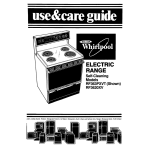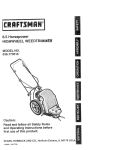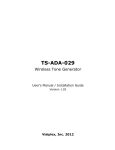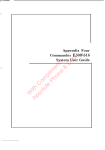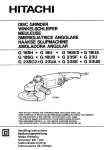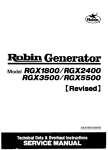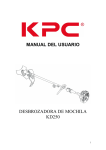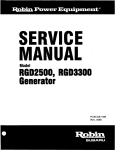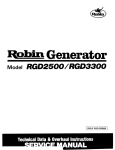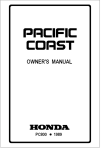Download Honda EB2200X User's Manual
Transcript
w The generator is a potential source of electrical shock if misused. Do not expose the generator to moisture, rain or snow. Do not let the generator get wet, and do not operate it with wet hands. Thank you for purchasing a Honda generator. This manual covers operation and maintenance of the EB2200X generator. All information in this publication is based on the latest product information available at the time of approval for printing. Honda Motor Co., Ltd. reserves the right to make changes at any time without notice and without incurring any obligation. No part.of this publication may be reproduced without written permission. This manual should be considered a permanent part of the generator and -should remain with the generator when it is sold. Pay special attention to statements preceded by the following words: m Indicates a strong possibility life if instructions are not followed. CAUTION: instructions Indicates a possibility, are not followed. of severe personal of personal injury injury or loss of or equipment damage if NOTE: Gives helpful information. If a problem should arise, or if you have any questions about the generator, consult an authorized Honda dealer. B Honda generators are designed to give safe and dependable service Read and understand the Owner’s if operated according to instructions. Manual before operating the generator. Failure to do so could result in personal injury or equipment damage. 1 CONTENTS CONTENTS 1. GENERATOR SAFETY ................................... 2. COMPONENT IDENTIFICATION : ............................ 3. PRlj-OPERATION CHECK .................................. 4. STARTING THE ENGINE ................................... 5. GENERATOR USE ........................................ .................................... l High altitude operation 6 .. STOPPING THE ENGINE .................................. ......................................... 7. MAINTENANCE ............................... 8. TRANSPORTING/STORAGE ..................................... 9. TROUBLESHOOTING : ......................... 10. SPECIFICATIONS ................ 11. WIRING DIAGRAM ...................................... 12. WARRANTY SERVICE ................................... 2 3 4 6 g 12 14 15 16 25 26 28 2g .3D 1. GENERATOR To ensure safe operation l l l l l l l l SAFETY - Place the generator at least 1 m (3 ft) away from buildings or other equipment during operation. Operate the generator on a level surface. If the generator is tilted, fuel spillage may result. Exhaust gas contains poisonous carbon monoxide. Never run the generator in an enclosed area. Se sure to provide adequate ventilation. Know how to stop the generator quickly and understand operation of all the controls. Never permit anyone to operate the generator without proper instructions. The generator is a potential source of electrical shock if misused. Do not expose the generator to moisture, rain or snow. Do not let the generator get wet, and do not operate it with wet hands. Keep children and pets away from the generator when it is in operation. Keep away from rotating parts while the generator is running. Connections for standby power to a building’s electrical system must be made by a qualified electrician and must comply with all applicable laws and electrical codes. Improper connections can allow electrical current from the generator to backfeed into the utility lines. Such backfeed may electrocute utility company workers or others who contact the lines during a power outage, and when utility power is restored, the generator may explode, burn, or cause fires ‘in the building’s electrical system. 3 2.COMPOlW3Wi- BDENTIFI AC RECEPTACLES AIR CL FILLER / FUEL VALVE II STARTER 4 \ OIL ALERT RECOIL STARTER EN’GINE SWITCH GRIP LAMP CAP FUEL TANK FUEL SPARK PLUG MUFFLER 5 3. PRE-OPERATDON CAUTION: stopped. CMECK Be sure to check the generator on a level surfaci with the engine 1. Check the engine oil level. CAUTION: Engine oil is a maljor factor affecting engine performance service life. Notidetergent or vegetable oils are not recommended. and Use Honda 4-stroke oil, or an equivalent high detergent, premium quality motor oil certified to meet or exceed U.S. automobile manufacturers” requirements for Service Classification SG,SF/CC,CD. Motor oils classified SG,SF/CC,CD will show this designation on the container. SAE 1 OW-30 is recommended for general, all-temperature use. Other viscosities shown in the chart may be used when the average temperature in your area is within the indicated range. Remove the oil filler cap, and wipe the dipstick with a clean reg. Check the oil level by inserting the dipstick in the filler hole without screwing it in. If the oil level is below the end of the dipstick, add oil to the upper !evel mark on the dipstick. NOTE: The Oil Alert System will automatically stop the engine before the oil level falls below the safe limit. However, to avoid the inconvenience of an unexpected shutdown, it is still advisable to visually inspect the oil level regularly. -20 -30 0 -20 20 -10 40 0 60 10 20 80 30 100°F 40°C UPPER LEVEL OIL FILLER Oli 6 FdER HOLE DiP STICK LbWER LEVEL 2. Check the fuel level Refill I the tank if the fuel level is low. Your engine is designed to use any gasoline that has a pump octane number (v) of 86 or higher, or that has a research octane number of 91 or higher. Gasoline pumps at service station normally display the pump octane number. We recommend that you use unleaded fuel because it produces fewer engine and spark plug deposits and extends the life of exhaust system components. Never use stale or contaminated gasoline or an oil/gasoline mixture. Avoid getting dirt, dust or water in the fuel tank. Use of a lower octane gasoline can cause persistent “pinging” or heavy “spark knock” (a metallic rapping noise) which, if severe, can lead to engine damage. CAUTION: If “spark knock” or “pinging” occurs at a steady engine speed under normal load, change brands of gasoline. If spark knock or pinging persists, consult your authorized Honda dealer. Failure to do so is considered misuse, and damage caused by misuse is not covered by Honda’s Limited Warranty. Occasionally you may experience light spark knock while operating under heavy loads. This is no cause for concern, it simply means your engine is operating efficiently. Clean the fuel filler screen regularly. Fuel tank capacity: 11 .O e (2.9 US gal) FUEL TANK CAP FUEL FILLER SCREEN 7 l l l l l Gasoline is extremely flammable and is explosive under certain conditions. Refuel in a well-ventilated area with the engine stopped. Do not smoke or allow flames or sparks in the area where the engine is refueled or where gasoline is stored. Do not overfill the fuel tank (there should be no fuel in the filler neck.) After refueling, make sure the tank cap is closed properly and securelY* Be careful not to spill fuel when refueling. Spilled fuel or fuel vapor may ignite. If any fuel is spilled, make sure the area is dry before starting the engine. Avoid repeated or prolonged contact with skin or breathing of vapor. KEEP OUT OF REACH OF CHILDREN. . ..’ ., GASOLINES CONTAINING ALCOHOL If you decide to use a gasoline containing alcohol (gasohol), be sure it’s cotane rating is at least as high as that recommended by Honda. There are two types of “gasohol”: one containing ethanol, and the other containing methanol. Do not use gasohol that contains more than 10% ethanol. Do not use gasoline containing methanol (methyl or wood alcohol) that does not also contain consolvents and corrosion inhibitors for methanol. Never use gasoline containing more than 5% methanol, even if it has consolvents and corrosion inhibitors. NOTE: l Fuel system damage or engine performance problems resulting front the use of fuels that contain alcohol is not covered under the warranty. Honda cannot endorse the use of fuels containing methanol since evidence of their suitability is as yet incomplete. l Before buying fuel from an unfamiliar station, try to find out if the fuel contans alcohol, if it does, confirm the type and percentage of alcohol used. If you notice any undesirable operating symptoms while using a gasoline that contains alcohol, or one that you think contains alcohol, switch to a gasoline that you know does: not contain ‘alcohol. 8 4. STARTING (1) Turn off the AC circuit breaker. (2) Turn on the fuel valve. (3) Turn on the engine switch. ON THE ENGINE Move the choke lever to the CLOSED position. (5) Pull the starter rope lightly until resistance is felt, then pull briskly. CAUTION: Do not. allow the starter grip to snap back.’ Return it slowly by hand. NOTE: Make sure the pilot lamp comes on. If not, check the bulb filament. (6) Move the’choke position lever to the OPEN as the engine warms up. Oil Alert System Before the oil level in the crankcase can fall below a safe limit, the Oil Alert System will automatically shut off the engine. The Oil Alert Lamp will light when the recoil starter grip is pulled. To restart, add enough recommended engine oil to bring the oil level to the upper level mark on the dipstick (See page 6), and restart the engine. ENGINE SWITCH OIL ALERT LAMP NOTE: The engine switch will remain in the ON position if the engine is stopped by the Oil Alert System. 11 l l To prevent elecrical shock from faulty appliances, the generator should be grounded. Connect a length of heavy wire between the generator’s ground terminal and an external ground source. Connections for standby power to a building’s electrical system must be made by a qualified electrician and must comply with all applicable laws and electrical codes. Improper connections can allow electrical current from the generator to backfeed into the utility lines. Such backfeed may electrocute utility company workers or others who contact the lines during a power outage, and when utility power is restored, the generator may explode, burn, or cause fires in the building’s electrical system. GROUND TERMINAL CAUTION L.imit operation requiring maximum power (2.2kVA) to 30 minutes. For continuous operation, do not exceed the rated power of 2.0 kVA. In either case, the total wattage of all appliances connected must be considered. l Most appliance motors require more than their rated wattage for start-up. l Do not exceed the current limit specified for any one receptacle. l 12 AC applications 1. Start the engine and plug in the appliance; always use three-pronged plugs. 2. Switch on the AC Circuit Breaker. CAUTION: Be sure that appliances do not exceed the generator’s rated load capacity for more than 30 minutes and that they never exceed the maximum load capacity. Substantial overloading will switch off the circuit breaker. Marginal overloading may not switch off the circuit breaker, but it will shorten the service life of the generator. Be sure that all appliances are in good working order before connecting them to the generator. If an appliance begins to operate abnormally, becomes sluggish, or stops suddenly, turn off the circuit breaker and the generator engine switch immediately. Then disconnect the appliance and examine it for signs of malfunction. NOTE: If an overloaded circuit causes the AC circuit breaker to switch off, reduce the electrical load on the circuit atid wait a few minutes before reset: ting the circuit breaker. NGED PLUG AC ClkCUlT BREAKER 13 l Hight altitude operation At high altitude, the standard carburetor air-fuel mixture will be excessively rich. Performance will decrease, and fuel consumption will increase. High altitude performance can be improved by installing a smaller diameter main fuel jet in the carburetor and readjusting the pilot screw. If you always ,operate the generator at altitudes higher than 6,000 feet above sea level, have your authorized Honda Generator dealer perform these carburetor modifications. Even with suitable carburetor jetting, engine horsepower will decrease approximately 3.5 % for each 1,000 foot increase in altitude. The affect of altitude on horsepower will be greater than this if no carburetor modification is made. CAUTION: Operation of the generator at an altitude lower than the carburetor is jetted for may result in reduced performance, overheating, and serious engine damage caused by an excessively lean air/fuel mixture. 14 6. STOPPING THE ENGINE To stop the engine in an emergency, turn the engine switch OFF. (1) Turn off the AC circuit breaker. (2) Turn off the engine switch. (3) Turn off the fuel valve. 7. MAINTENANCE The purpose of the maintenance and adjustment schedule is to keep the generator in the best operating condition. Inspect or service as scheduled in the table on the next page. B Shut off the engine before performing any maintenance. If the engine must be run, make sure the area is well ventilated. The exhaust contains poisonous carbon monoxide gas. CAUTION: placement generator. Use genuine HONDA parts which are not parts or their of equivalent equivalent. The use of requality may damage the Tool kit The tools supplied are necessary.for performing some periodic maintenance, simple adjustments and repairs. Always keep the tool kit with the generator. 16 Maintenance REGULAR Schedule SERVICE Perform at every indicated month or operating hour interval, Inspection Daily First month or 20 Hrs. Every 3 months or 50 Hrs. Every 6 months or 100 Hrs. Every year or 300 Hrs. 0 Engine oil 0 Change Air cleaner NOTE Inspection 0 0 (1) : Service every 10 hours or once a day when used in dusty areas. Honda dealer, unless the owner has the proper tools and is mechanically proficient. See the Honda Shop Manual. (2) : These items should be serviced by an authorized 17 Changing oil Drain the oil while the engine is still warm to assure rapid and complete draining. 1. Remove the drain plug and filler cap, and drain the oil. Retighten the plug securely. 2. Refill with the recommended oil (see page 6) and check the level. 01 L CAPACITY: 0.6 9 (0.63 USqt) OIL DRAIN PLUG CAUTION: Used motor oil may cause skin cancer if repeatedly left in contact with the skin for prolonged periods. Although this is unlikely unless you handle used oil on a daily basis, it is still advisable to thoroughly wash your hands with soap and water as soon as possible after handling used oil. NOTE: Please dispose of used motor oil in a manner that is compatible with the environment. We suggest you take it in a sealed container to your local service station for reclamation. Do not throw it in the trash or pour it on the ground. 18 Air cleaner service A dirty air cleaner will restrict air flow to the carburetor. To prevent carburetor malfunction, service the air cleaner regularly (page 17). Service more frequently when operating the generator in extremely dusty areas. B Never use gasoline or low flash point cleaner element. A fire or explosion could result. CAUTION: Never run the genetrator wear will result. without solvents for cleaning the air cleaner. the air Rapid engine 1. Unsnap the air cleaner cover springs, remove the air cleaner cover and remove the element. 2. Wash the element in a non-flammable or high flash point solvent and dry it thoroughly. 3. Soak the element in clean engine oil and squeeze out the excess oil. 4. Reinstall the air cleaner element and the cover. CO< ER SPRINGS E’LEMENT 19 Fuel filter service The filter prevents dirt or water which may be in the fuel tank from entering the carburetor. If the engine has not been run for a long time, the filter should be cleaned. 1. Turn the fuel valve OFF. Remove the filter cup. 2. Clean the cup thoroughly. 3. Reassemble. Do not damage the rubber gasket. B After installing the filter cup, check for fuel leaks and make sure the area is dry before starting the engine. a 20 FILTER CUP . Spark plug service Recommended spark plug: BPGES, BPRGES (NGK) W20EP-U, W20EPR-U (ND) To ensure proper engine operation, the spark plug must be properly gapped and free of deposits. 1. Remove the spark plug cap. 2. Clean any dirt from around the spark plug base. 3. Use the wrench supplied in the tool kit to remove the spark plug. PLUG CAP 4. Visually inspect the spark plug. Discard it, if the insulator is cracked or chipped. Clean the spark plug with a wire brush if it is to be reused. 5. Measure the plug gap with a feeler gauge. The gap should be 0.7-0.8 mm (0.028-0.031 in).Correct as necessary by carefully bending the side electrode. 0.7-0.8 mm (0.028-0.0 31 in) 21 6. Attach the plug washer and thread the plug in by hand to prevent cross threading. 7. After a new spark plug has been seated by hand, it should be tightened l/2 turn with a wrench to compress its washer. If a used plug is being reinstalled, it should only require l/8 to l/4 turn after beingseated. CAUTION: The spark plug must be securely tightened. An improperly tightened can become very hot and could possibly damage the generator. l Never use a spark plug with an improper heat range. l 22 plug Spark arrester maintenance m Allow If the generator has been running, it to cool before proceeding. the muffler will be very hot. CAUTION: The spark arrester must be serviced every 100 hours to maintain its efficiency. 1. Loosen the five 6 mm bolts to remove the muffler protector. PROTECTOR Five 8 mm bolts 2. Remove the two 8 mm bolts at the exhaust pipe and the 8 mm bolt at the muffler stay. Remove the muffler and the spark arrester. Two 8mm bolt SPARK ARRESTER / MUFFLER 23 3. Use a brush to remove carbon deposits from .the spark arrester screen. NOTE: Inspect the spark arrester screen for holes or tears. Replace if necessary. 4. Check the exhaust pipe gasket and replace if damaged. Reinstall the’ muffler and the protector. 24 8. TRANSPORTING/STORAGE hw When transporting the generator, turn the engine switch OFF and keep the generator level to prevent fuel spillage. Fuel vapor or spilled fuel may ignite. Before storina the unit for an extended period: 1. Be sure thestorage area is free of excessive humidity and dust. 2. Drain the fuel a. With the fuel valve OFF, remove and empty the filter cup. b. Turn the fuel valve ON and’ drain the gasoline in the fuel tank into a suitable container. c. Replace the filter cup and tighten securely. d. Loosen the carburetor drain screw and drain the gasoline from the carburetor into a suitable container. . 3. Slowly pull the starter grip until resistance is felt. At this point, the piston is coming up on its compression stroke and both the intake and exhaust valves are closed. Storing the engine in this position will help to protect it from internal corrosion. I STARTER GRIP 25 9. TROUBLESHOQT’ONG When the engine will not start: 1 Is there fuel in the tank? 1 1 Refill the fuel tank. NO YES Is the engine\. on? I NO Turn the engine switch on. NO Turn the fuel valve on. Add the recommended oil. t YES Is there a spark from the spark plug? pulling the starter grip) NO 4 Replacethe spark plug 1 Still Nospark . Tocheck: 1) Remove the spark plug cap and Be sure there is no spiland clean any dirt from around .the spark plug. led fuel around the 2) Remove the spark plug and inspark plug. Spilled fuel stall the spark plug in the plug may ignite. cap. 3) Set the plug side electrode on YES the cylinder head. 4) Pull the recoil starter, sparks should jump across the gap. c!amm Is the fuel reaching. the carburetor? I YES does not start, take the generator to an authorized HONDA 26 NO To check 1) Turn off the fuel valve and remove the drain screw. 2) Fuel should flow from the drain when the fuel valve is turned on. d=I I No electricity at the AC receptacles: Is the AC circuit breaker on? NO YES Check the electrical appliance or equipment for any defects I NO DEFECTS w DEFECTS ) Take the generator to an authorized Honda dealer. equipment. * Take the electrical appliance or equipment to an electrical shop for repair. 27 Dimensions 505 x 420 x 420 mm (19.9 x 16.5 x 16.5 in) Length x Width x Height 43.0 kg Dry Weight I I I Engine Model Engine Type Displacement [Bore x Stroke] Compression Ratio Engine Speed Cooling System Ignition System Oil Capacity Fuel Tank Capacity Spark Plug HONDA GX140 4-Stroke, O.H.V. 1 cylinder (25” tilted) 144 cm3 (8.8 cu in) 64 x 45 cm (2.5 x 1.B in) 8.75 : 1 3600 rpm Forced air cooled Transistor Magnet Ignition 0.6 Q (0.63 USqt) 11.0 II (2.9 USgal) BPGES, EPRGES (NGK) W20EP-U,, WZOEPR-U (ND) Generator ( Rated voltage Rated frequency AC output I 28 ( 120v 60Hz Rated ampere 16.7 (A) Rated output 2.0 kVA (2OOOW) 1 Maximum output 1 2.2 kVA (22OOW) I II -WIRING / v) Itl Y k B ! ‘ 0 i L I r l- 1 - - >‘, ID DL . \ DIAGRAM Owner Satisfaction Your satisfaction and goodwill are important to your dealer and to us. All Honda warranty details are explained in the Distributor’s Limited Warranty. Normally, any problems concerning the product will be handled by your dealer’s service department. If you have a warranty problem that has not been handled to your satisfaction, we suggest you take the following action: l l Discuss your problem with a member of dealership management. Often complaints can be quickly resolved at that level. If the problem has already been reviewed with the Service Manager, contact the owner of the dealership or the General Manager. If your problem still has not been resolved to your satisfaction, contact: American Honda Motor Co., Inc. P.O. Box 100021 Duluth, Georgia 30136-9421 Telephone: (404) 497-6400 We will need the following - information Your name, address, and telephone Product model and serial number Date of purchase Dealer name and address Nature of the problem in order to assist you: number After reviewing all the facts involved, you will be advised of what action can be taken. Please bear in mind that your problem will likely be resolved at the dealership, using the dealer’s facilities’, equipment, and personnel, so it is very important that your initial contact be with the dealer. Your purchase of a Honda product is greatly appreciated by both your dealer and American Honda Motor Co., Inc. We want to assist you in every way possible to assure your complete satisfaction with your purchase. 30 MEMO 31 MEMO 32




































